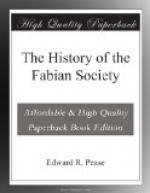Mrs. Wells acted as secretary, and the Committee took evidence from myself and others before the report was drawn up.
The Report of the Committee is a much less inspiring document than the irresponsible and entertaining “Faults of the Fabian.” It was largely concerned with a number of administrative details. New books and “short readable tracts” were to be written, and the format of our publications was to be changed. Groups were to be revived in all localities (to be called “Wandsworth 1, Wandsworth 2, Wandsworth 3,” and so on), together with Head-quarters groups, also numbered 1, 2, 3, etc. This perhaps is the chief remaining trace of the megalomania of the original scheme, and is hidden away in an appendix: all our efforts never yielded Wandsworth No. 1, let alone the others! A fixed minimum subscription payable on a fixed date and a list of subscriptions to be published annually were further suggestions. The rule of the Society had been and is to the contrary in both particulars. “Fabian News” was to be enlarged into a weekly review addressed to the public, a change which would have required an editorial staff and extensive new offices. A publications editor was to be appointed who would be able to publish, or to arrange for the publication of, such books as Mr. Wells’ “A Modern Utopia” and Mr. Money’s “Riches and Poverty.” The Basis of the Society was to be rewritten, its name changed to the British Socialist Party—a title since adopted by the old Social Democratic Federation—the Executive Committee was to be replaced by a Council of twenty-five, which was to appoint three Committees of three members each for Publishing, for Propaganda, and General Purposes respectively. The last, to be entitled the Directing Committee, was to meet frequently and manage most of the affairs of the Society. Finally, “in harmonious co-operation with other Socialist and Labour bodies,” the Society was to run candidates for Parliament and raise a fund for the purpose.
It will be seen that some of these proposals were merely speculative. Groups could be organised easily enough when the members in any district numbered hundreds instead of units, or, at best, dozens. New tracts could be published when they were written: a weekly review was possible if the capital was provided. The new Basis and the new name were matters of emphasis and taste rather than anything else. The new machinery of government was in the main a question to be decided by experience. Mr. Wells had none; it is said that he never sat on a Committee before that under discussion, and certainly while he remained a Fabian he never acquired the Committee habit. On the principle underlying some of these proposals, viz. that the Society should cease to treat membership as a privilege, and should aim at increasing its numbers, there was no serious controversy. The Executive Committee had already carried through a suggestion made in the discussion on “Faults of the Fabian”




